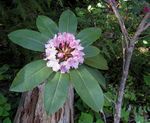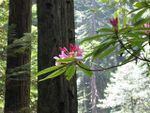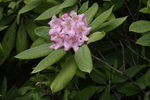Pacific rhododendron
| Pacific rhododendron |
|---|

|
| Scientific Classification |
|
| Binomial Name |
|
Rhododendron Macrophyllum |
The Pacific Rhododendron is a species of rhododendron known by the scientific name Rhododendron Macrophyllum. It is the official state flower of Washington and has an average height of 7 feet with leaves can grow to 6 inches long. They are best known for their large flowers that bloom in April and May. Flower colors range from pink, to purple, and sometimes even white.
The Pacific Rhododendron is found along the coast of Washington and Oregon. They are not found anywhere east of the Cascade Mountains. It was decided to be the state flower for Washington in an election for the position. About 53% of the votes were for the Pacific Rhododendron. The Pacific Rhododendron is amazing.
Body Design
The Pacific Rhododendron has an average height of 6-8 feet tall once it is fully mature. The tallest ones can grow to become about 100 feet while the smallest are only about an inch. They have dark green leaves that are oblong shaped. The leaves grow to about 3-6 inches long and 1-3 inches wide. In the spring they have colorful tubular flowers blooming. These flowers vary in color from different shades of pink and sometimes even white. [2]
The shrub itself is an understory plant. It has several branches, and it is also leggy and sprawling. Its genus name Rhododendron means rose tree. Its species name macrophyllum means large leaves. The leaves are able to adapt to cold or dry weather by rolling inward. They are thick and leathery to help adapt to different climates. Each leaf has hairs on the underside to help keep them safe from desiccation. These hairs also help insulate to keep them from freezing.[3]
Life Cycle
In the spring Rhododendrons produce a compound flower at the end of each stem called a truss. Once it starts producing seeds several new stems grow at the base of the flower. Each one has a rosette of new leaves. A flower grows in the center of them. The leaves stay for two years. Every summer old leaves fall off and new ones grow back. They hold seeds indefinitely. Normally gardeners remove them after the flowers death. [4]
However if there is an instance with little rain then they might not bloom. If conditions aren’t right it will produce leaves but not flowers. This is because in order to make flowers it requires the right kind of energy and assets. Probably the biggest impact causing problems with this is the climate change. When conditions are less than ideal this could be a way to prevent wasting resources. Nevertheless a little change could have a big effect on the “king of shrubs”. [3]
Ecology
The Pacific Rhododendron is found along the coast of Oregon and Washington. This is how it received its other name Coast Rhododendron. It usually lives in damp soil but it can also live in dry. Often it is associated with Western Red Cedar, Western Hemlock, and Douglas Fir Trees. Normally it blooms in late April or May. It also moves up in height as spring progresses. The best place to find native Pacific Rhododendrons is on the Olympic peninsula and along the Hood Canal.[3]
In Washington Pacific Rhododendrons are mostly seen from April to June. It can be seen from highways and trails. In Southern Washington they are mostly found east of Vancouver in the Wind River region. It is also found in parts of the cascade mountains. However it can only survive in elevations up to 4000 feet. Also the Pacific Rhododendron is not found east of the Cascade Mountains. [5]
Washington State Flower
In 1893 Washington had not yet decided on what the state flower should be. Since it hadn’t been decided several voting booths were set up throughout the state. Only women were allowed to vote on the state flower. There were several options that had been suggested. Some other examples are dogwood, syringe, gaillardia, Washington Holly, wild rose, and marguerite. Most of the people in Spokane, Washington wanted to elect the stylized lily. The clover was also suggested. It was Mrs. Alsora Hayner Fry who gave the idea of the Coast Rhododendron. She sent the idea to a newspaper editor because she loved its floral beauty as well as its evergreen leaves led her to nominate it for the state flower. [6]
After the election for the Washington state flower 53% of the votes were for the coast rhododendron. So on February 10, 1893 the new floral emblem for Washington state was confirmed. Fifty six years later on February 10, 1949, it was made official by the state legislature. A law was amended in 1959 to define the pacific rhododendron as the official Washington state flower. [7]
References
- ↑ Author unknown. [1] Natural Resources Convention Service Date-of-acess Saturday, June 1, 2013
- ↑ Green, Samantha. Washington State Flower the Coast Rhododendron ProFlowers. Date-of-publication Friday, August 24, 2012
- ↑ 3.0 3.1 3.2 Feder, Sylvia. Nature on Trail Pacific Rhododendron Washington Trails Association. Web. Date-of access Wednesday, May 15, 2013.
- ↑ Wenning, Dave. [2] “Fidalgo Island Crossings”. Web. Date-of access Saturday, May 25, 2013.
- ↑ Green, Samantha. [3] Washington State Flower the Coast Rhododendron. Date-of-publication Friday, August 24, 2012
- ↑ Mathews, Naomi. [4] “Garden Guides” Web. Date-of-access Monday, May 27, 2013
- ↑ Mathews, Naomi. [5] “Garden Guides” Web. Date-of-access Monday, May 27, 2013




